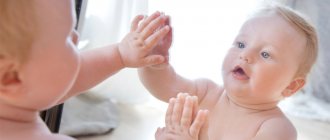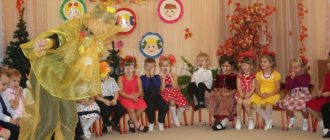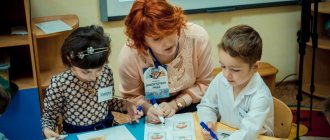“Development of speech of children in the younger group using finger games and non-traditional technologies”
“Development of speech of children in the younger group using finger games and non-traditional technologies.”
Relevance:
Speech in human life is the most important function necessary for everyone. Without speech, without spoken words, life would be boring and uninteresting. Thanks to speech, we communicate, convey experience, regulate activity and behavior.
The age from 3 to 4 years is of particular importance for the child’s speech development. The main task of a teacher in the field of speech development for children of primary preschool age is to help them master spoken language and their native language.
“A child’s mind is at his fingertips” V.A. Sukhomlinsky" “The hand is, in a way, the external brain of a person,” Kant wrote.
In our preschool, much attention is paid to the development of children's speech. It has been proven that a child’s thought and eye move at the same speed as the hand. This means that systematic exercises to train finger movements are a powerful means of increasing brain performance. His further development depends on how deftly a child learns to control his fingers. Along with the development of fine motor skills, memory, attention, and vocabulary develop.
To develop children's speech, we use finger games and non-traditional technologies in our work. I chose the topic of self-education “Development of speech of children in the second junior group using finger games and non-traditional technologies”, since this topic is very relevant and is of no small importance in the lives of my students. Organized games, including finger games, accompanied by speech, turn into unique small performances. They captivate children and bring them joy. Work on the development of fine motor skills involves close communication with children and parents, which has a beneficial effect on relationships and a friendly atmosphere in the children's team.
Period of work on the topic: 1 year
Month of starting work on the topic: September 2022
Completion month: May 2022
Goal: increasing your theoretical level, professional skills and competence.
Tasks:
1. Integrate finger games and exercises into children’s speech activities;
2. Improve children's fine motor skills through finger games;
3. Systematize work to improve finger motor skills;
4. To provide parents with knowledge about the importance of finger games and non-traditional forms of working with children.
5. Promote the normalization of speech function.
6. Develop imagination, logical thinking, voluntary attention, visual and auditory perception, creative activity.
Methods and techniques of work:
Traditional:
Finger play training. Hand massage. Finger gymnastics, physical education sessions. Finger tigers with poems and tongue twisters. Finger Theater.
Non-traditional technologies:
Modeling from plasticine and salt dough using natural materials (cereals, shells, etc.) Construction from paper using the origami technique, working with constructs. Various types of applications.
Laces. Puzzles, mosaic. Working with counting sticks. Self-massage of hands and fingers. Unconventional drawing techniques: brush, finger, toothbrush, candle. Manual labor: stringing beads. Drawing with stencils, shading.
Stages of self-education:
O Selection and study of methodological literature.
O Formation of experience on the topic.
O Presentation of a presentation on the topic: “Development of speech of children in the younger group using finger games and non-traditional technologies.”
List of methodological literature:
1. O.I. Krupenchuk “Training fingers, developing speech” St. Petersburg 2013
2.O.I. Krupenchuk “Poems for speech development” St. Petersburg 2014
3.E. A. Yanushko “Development of fine motor skills in young children” Moscow 2009
4.T. Y. Bardysheva “Tell poetry with your hands” Moscow 2014
5. “Games for the development of fine motor skills using non-standard equipment.” St. Petersburg. CHILDHOOD PRESS 2013
6. Speech development in kindergarten. Program and methodological recommendations. — 2nd ed., rev. and additional V. - M.: Mozaika-Sintez, 2010.
Work plan for the 2021-2022 academic year.
| Month | Forms of work |
| September | Studying methodological literature on this topic. Diagnostics |
| October | Introduce it into work with children. Hand massage. |
| November | Make a card index of games to develop fine motor skills. Finger gymnastics. |
| December | Manual labor: stringing beads, lacing. Drawing with stencils, shading. |
| January | Development of fine motor skills of the hands in the process of visual activity. We draw in an unconventional way. Puzzles, mosaics, working with counting sticks. |
| February | Learning new finger games, repeating old ones. Consultation for parents: “Finger gymnastics for the development of children’s speech.” |
| March | Workshop for parents: “The importance of finger games for the development of speech of children in the second junior group.” |
| April | Reading stories, nursery rhymes, poems is a feast for the help of fingers. Finger Theater. Design from paper using the origami technique. |
| May | Presentation of a presentation on the topic: “Development of speech of children in the second junior group using finger games and non-traditional technologies” |
Workshop for parents: “The importance of finger games for the development of speech of children in the second junior group.”
Goal: Creating conditions for increasing the pedagogical literacy of parents about the role of fine motor skills in the development of pupils’ speech.
Tasks:
1. Arouse parents’ interest in the pedagogical process in preschool educational institutions.
2. To give parents theoretical knowledge about the importance of the development of fine motor skills of the hands in the general and speech development of the child.
3. Provide practical recommendations on the use of games and exercises aimed at developing fine motor skills.
Preliminary work:
· Selection of manuals, games, literature on the topic.
· Preparation of visual materials and practical recommendations for parents.
· Design of a brochure for parents “Let’s play, kids!”
Equipment: interactive whiteboard; brochure with a selection of finger games; board games that promote the development of fine motor skills.
Progress of the workshop
I. Greetings from parents.
At the beginning of the event, we invite parents to “return to childhood”: “Probably, each of you remembers your childhood well. And, looking at our children, we often think about how good it was in our childhood... And the candies were sweeter, and the ice cream was tastier... I suggest you briefly plunge into the wonderful and magical world of childhood...”
Exercise “Journey to Childhood”
(Parents are invited to listen to a fragment of the song “Magic Country.”)
II. Warm up your fingers
And now we will play with our fingers in our magical land of childhood.
"Snowball"
One, two, three, four, (Bend your fingers, starting with the thumb.)
You and I made a snowball. (“They sculpt” by changing the position of the palms.)
Round, strong, very smooth (Show a circle, clasp your palms together, stroke the other with one palm.)
And not at all sweet. (They shake their finger.)
Once - we'll throw it up. (They throw an imaginary snowball, look up.)
Two - we'll catch it. (They crouch down and catch an imaginary snowball.)
Three - we'll drop it. (They get up and drop an imaginary snowball.)
And... we'll break it. (They stomp.)
N. Nishcheva.
“We went for a walk in the yard
One, two, three, four, five, (Bend your fingers one at a time.)
We went for a walk in the yard. (“Walk” along the table with the index and middle fingers.)
They sculpted a snow woman (“They sculpt” a lump with two palms.)
The birds were fed crumbs (“They crumble the bread” with all their fingers.)
Then we rode down the hill, (Run the index finger of the right hand along the palm of the left hand.)
And they were also lying in the snow. (Put their palms on the table, first one side, then the other.)
Everyone came home covered in snow. (They shake off their palms.)
We ate soup and went to bed. (Moves with an imaginary spoon; hands under the cheek.)
N. Nishcheva.
"Herringbone
In front of us is a Christmas tree: (The fingers are intertwined, the thumbs make up the “top” of the Christmas tree.)
Cones, needles, (Clenched fists, then spread fingers.)
Balls, lanterns, ("Balls" from fingers up, "flashlights" - down.)
Bunnies and candles, (“Ears” made from index and middle fingers, then palms folded together.)
Stars, people. (Palms are folded, fingers are straightened, then the index and middle fingers are on the table.)
N. Nishcheva.
Next, parents are invited to help collect the beads
Game "Who is faster" (Musical accompaniment - "Mustachioed Nanny.")
"A little theory"
Dear parents!
Today we will talk about the importance of developing fine motor skills in the development of children's speech. Once a famous teacher V.A. Sukhomlinsky said: “The sources of children’s creative abilities and talents are at their fingertips. From the fingers, figuratively speaking, come the finest streams that feed the source of creative thought. In other words: the more skill in a child’s hand, the smarter the child.”
Fine motor skills are a set of coordinated actions of the nervous, muscular and skeletal systems, often in combination with the visual system, in making small and precise movements of the hands and fingers and toes.
A lot of books and manuals have been written recently about fine motor skills. And this is no coincidence. Scientists have come to the conclusion that the formation of a child’s oral speech begins when the movements of the fingers reach sufficient accuracy. In other words, speech formation occurs under the influence of impulses coming from the hands. This is also important for timely
speech development, and especially in cases where this development is impaired. In addition, it has been proven that both the child’s thought and eye move at the same speed as the hand. This means that systematic exercises to train finger movements are a powerful means of increasing brain performance. At today's seminar we will talk about traditional and non-traditional forms of development of fine motor skills, what types of work to improve fine motor skills we all use in our practice. The hand is so connected with our thinking that it has become an auxiliary part of our language. Everything that is elusive, inexpressible in a person, that cannot find words, seeks expression through the hand. A gesture, like a word, can elevate a person, calm, caress, confirm words, make them more significant.
Let's digress a little and conduct a small experiment: clench your hands into a fist, and now throw one finger out of the fist. How easy is this exercise for you? And a little more complicated: put your palms out, connect two fingers: the ring finger with the little finger, and the index finger with the middle finger; the nameless one with the middle one, and the rest apart.
Have you ever wondered where the area responsible for the ability to speak is located? Broca's area is located in the posterior inferior part of the third frontal gyrus of the left hemisphere in people who write with their right hand. For left-handed people the opposite is true. This area of the cortex controls the muscles of the face, tongue, pharynx and jaws. When Broca's center is damaged, motor aphasia is observed. Patients cannot read or write, but understand speech. Wernicke's area is responsible for understanding information. Its main function is to convert speech sounds into neural codes of words that activate corresponding images or concepts. Damage to this area affects a person's ability to perceive speech sounds as linguistically meaningful. It is located in the posterior part of the superior temporal gyrus of the dominant (for right-handed people - mainly the left) hemisphere of the brain.
You can develop your baby's hands from birth. Whether he is squeezing our strong fingers with his tiny fingers, grasping and holding rattles, or trying to catch his own feet, he is already in the process of development.
Main types of activities with a child
1. Massage - daily thorough massage of the hands: soft massaging movements and kneading of each finger, palm, outer side of the hand, and forearm.
2. Bean baths - pour beans or peas into a bowl or box, throw small toys in there and stir. The baby puts his hands in the beans and looks for toys. Effects: massage, development of finger coordination.
3. Modeling from different materials (salt dough, plasticine, clay, regular dough). In addition to the obvious creative expression, the baby also develops flexibility and dexterity in the fingers and helps improve speech.
4. Mosaic - playing with different mosaics also improves fine motor skills, develops intelligence and creativity.
5. Finger gymnastics and finger games - many books are devoted to these fun activities.
6. Lacing – now in educational toy stores there is a sufficient assortment of various lacing games. They perfectly develop fine motor skills of the hands, and thanks to them, the baby masters the everyday practical skill of lacing shoes.
7. Games with buttons and beads - stringing on a thread, fastening buttons on loops, fingering beads from buttons or beads.
8. Rolling pencils, balls with your palm on a table or other surface. This activity is an additional massage of the palms and improves coordination of hand movements.
9. Draw. Holding pencils and brushes in your hands is an excellent way to develop motor skills, just as good as special exercises. Teach your child to trace drawings and objects along the contour.
10. Cut out different figures from paper. Start with simple ones - a circle, square or triangle, then you can cut out complex pictures.
11. Motor skills are also developed by other simple and familiar activities - braiding hair, combing dolls, putting toys in places and much more.
12. While walking, build castles, slides, and other figures from sand or pebbles.
13. Call your child to help you with the housework - making dumplings, kneading dough, weeding beds, sewing, picking berries - a great alternative to games.
Use a creative approach when working with your child and accompany all activities with fairy tales invented along the way. Verbal reinforcement of exciting actions will double the effect.
Reflection
Choose a brick on the table that suits you best and glue it to the house. Red – “I received a lot of useful information about the development of speech and fine motor skills, I will use it in raising my child”; Yellow – “It was interesting, maybe I can use something”; Brown - “It’s a waste of time, I didn’t take anything new for myself.”
Get text




